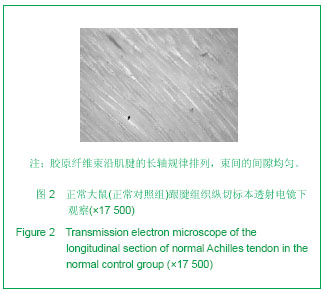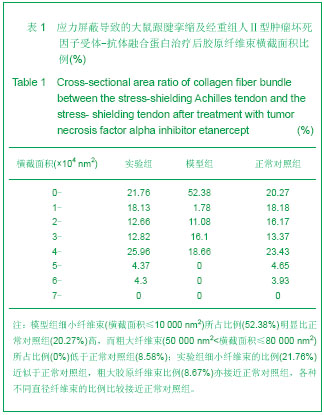| [1] Hosaka YZ, Uratsuji T, Ueda H, et al. Comparative study of the properties of tendinocytes derived from three different sites in the equine superficial digital flexor tendon. Biomed Res. 2010;31(1):35-44.[2] Uchida H, Tohyama H, Nagashima K, et al. Stress deprivation simultaneously induces over-expression of interleukin-1beta, tumor necrosis factor-alpha, and transforming growth factor-beta in fibroblasts and mechanical deterioration of the tissue in the patellar tendon. J Biomech. 2005;38(4):791-798.[3] Knobloch K. Comment on: Monitoring Achilles enthesitis in ankylosing spondylitis during TNF-alpha antagonist therapy: an ultrasound study. Rheumatology (Oxford). 2010;49(7): 1418-1419. [4] Smolen JS, Nash P, Durez P, et al. Maintenance, reduction, or withdrawal of etanercept after treatment with etanercept and methotrexate in patients with moderate rheumatoid arthritis (PRESERVE): a randomised controlled trial. Lancet. 2013; 381(9870):918-929.[5] Chang B, Park HY, Jeon K, et al. Interferon-γ release assay in the diagnosis of latent tuberculosis infection in arthritis patients treated with tumor necrosis factor antagonists in Korea. Clin Rheumatol. 2011;30(12):1535-1541.[6] Jung YS, Park W, Na K. Temperature-modulated noncovalent interaction controllable complex for the long-term delivery of etanercept to treat rheumatoid arthritis. J Control Release. 2013;171(2):143-151. [7] Tanida A, Kishimoto Y, Okano T, et al. Etanercept Promotes Bone Formation via Suppression of Dickkopf-1 Expression in Rats with Collagen-Induced Arthritis. Yonago Acta Med. 2013; 56(1):13-19.[8] Martínez-Santana V, González-Sarmiento E, Calleja-Hernández M, et al. Comparison of drug survival rates for tumor necrosis factor antagonists in rheumatoid arthritis. Patient Prefer Adherence. 2013;7:719-727. [9] The Ministry of Science and Technology of the people Republic of China.Guidance Suggestions for the Care and Use of Laboratory Animals.2006-09-30.中华人民共和国科学技术部. 关于善待实验动物的指导性意见. 2006-09-30.[10] Cui Q,Wang Z, Jiang D,et al. HGF inhibits TGF-β1-induced myofibrobroblast differentiation and EMG deposition via MMP-2 in Achilles tendon in rat. Eur J Appl Physiol.2011; 111(7):1457-1463.[11] 王伟,马燕红.大鼠跟腱应力屏蔽挛缩模型的建立[J].中国康复理论与实践,2009:15(6):521-523.[12] 晏小艳,马燕红.IL-1受体拮抗剂干预跟腱挛缩的实验研究[J].中国康复,2011,26(4):25-28.[13] Palmes D, Spiegel HU, Schneider TO,et al. Achilles tendon healing:Long-term biomechanical in a new mouse model.J Orthop Res.2002;20(5):939-946.[14] Ricco S, Renzi S, Del Bue M, et al. logeneic adipose tissue-derived mesenchymal stem cells in combination with platelet rich plasma are safe and effective in the therapy of superficial digital flexor tendonitis in the horse. Int J Immunopathol Pharmacol. 2013;26(1 Suppl):61-68. [15] Noh MK, Jung M, Kim SH, et al. Assessment of IL-6, IL-8 and TNF-α levels in the gingival tissue of patients with periodontitis. Exp Ther Med. 2013;6(3):847-851. [16] Rich T, Henderson LB, Becker DL, et al. Indicators of replicative damage in equine tendon fibroblast monolayers. BMC Vet Res. 2013;9(1):180. [17] Schulze-Tanzil G, Al-Sadi O, Wiegand E, et al. The role of pro-inflammatory and immunoregulatory cytokines in tendon healing and rupture: new insights. Scand J Med Sci Sports. 2011;21(3):337-351. [18] de Araújo RF Júnior, Souza TO, de Moura LM, et al. Atorvastatin Decreases Bone Loss, Inflammation and Oxidative Stress in Experimental Periodontitis. PLoS One. 2013;8(10):e75322.[19] Akhter N, Nix M, Abdul Y, et al. Delta-Opioid Receptors Attenuate TNF-α-Induced MMP-2 Secretion From Human ONH Astrocytes. Invest Ophthalmol Vis Sci. 2013;54(10): 6605-6611. [20] Tsuzaki M, Guyton G, Garrett W, et al.IL-1 beta induces COX2, MMP-1, -3 and-13, ADAMTS-4, IL-1 beta and IL-6 in human tendon cells.J Orthop Res.2003;21(2):256-264.[21] Li XM, Dong L, Shi HT, et al. Effect of neferine on hepatic stellate cells in collagen-I, TIMP-1 and MMP-2. Zhongguo Zhong Yao Za Zhi. 2013;38(13):2206-2209. [22] Ji Y, Wang T, Wei ZF, et al. Paeoniflorin, the main active constituent of Paeonia lactiflora roots, attenuates bleomycin-induced pulmonary fibrosis in mice by suppressing the synthesis of type I collagen. J Ethnopharmacol. 2013; 149(3):825-832. [23] Furtwängler T, Chan SC, Bahrenberg G, et al. Assessment of the Matrix Degenerative Effects of MMP-3, ADAMTS-4, and HTRA1, Injected Into a Bovine Intervertebral Disc Organ Culture Model. Spine (Phila Pa 1976). 2013;38(22): E1377-1387. [24] Thornton GM, Shao X, Chung M,et al. Changes in meehanical loading lead to tendon-specific alterations in MMP and TIMP expression:Influence of stress-deprivation and intermittent cyclic hydrostatic compression on rat supraspinatus and Achilles tendons.Br J Sports Med. 2010; 44(10)698-703.[25] Kameda H. Etanercept. Nihon Rinsho. 2013;71(7): 1214-1217.[26] Horii M, Orita S, Nagata M,et al., Direct application of the tumor necrosis factor-alpha inhibitor, etanercept, into a punctured intervertebral disc decreases calcitonin gene-related peptide expression in rat dorsal root ganglion neurons. Spine (Phila Pa 1976). 2011;36(2):E80-85.[27] Rolle AS, Zimmermann B, Poon SH. Etanercept-induced Henoch-Schönlein purpura in a patient with ankylosing spondylitis. J Clin Rheumatol. 2013 ;19(2):90-93. [28] Zitelli KB, Zedek D, Ranganathan P, et al. Squamous cell carcinoma of the lip associated with adalimumab therapy for ankylosing spondylitis: a case report and review of TNF-α inhibitors and cutaneous carcinoma risk. Cutis. 2013;92(1): 35-39. [29] Ma YH, Yan XY, Zhao HK et al. Effects of interleukin-1 receptor antagonist on collagen and matrix metalloproteinases in stress-shielded achilles tendons of rats. Orthopedics. 2012;35(8):e1238-1244.[30] Miyatake S, Tohyama H, Kondo E, et al. Local administration of interleukin-1 receptor antagonist inhibits deterioration of mechanical properties of the stress-shielded patellar tendon. J Biomech. 200;41(4):884-889. |





.jpg)